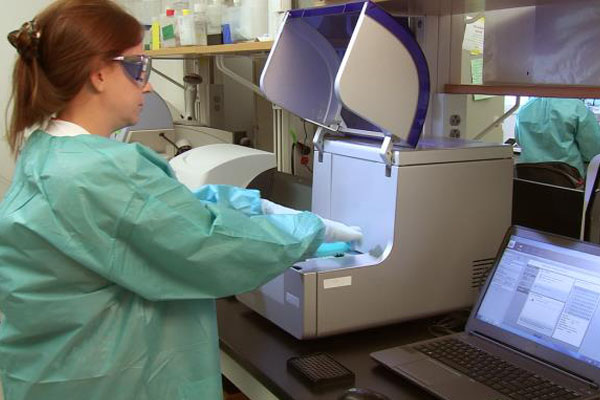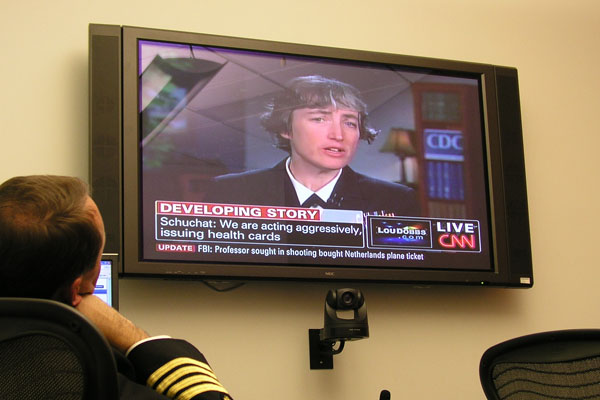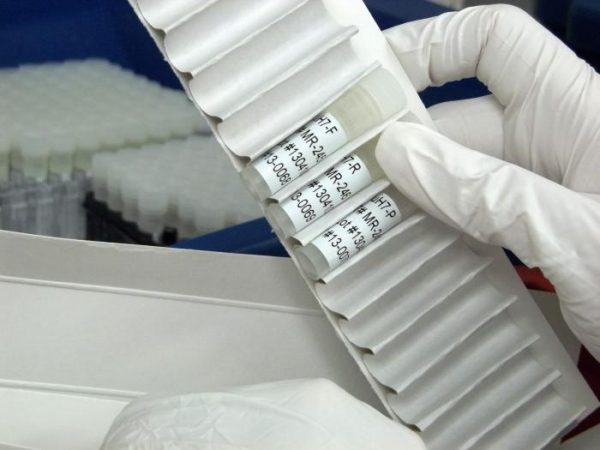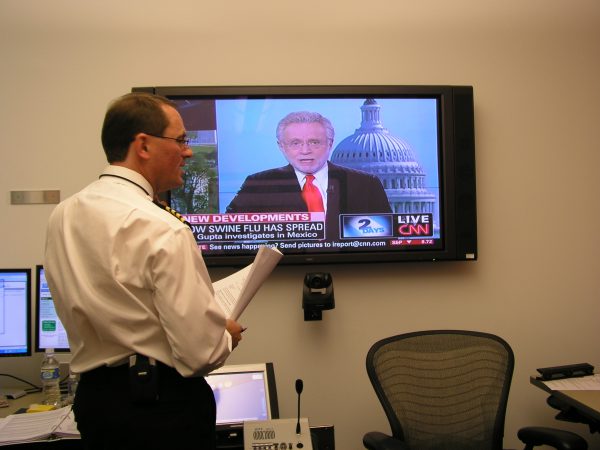2009 H1N1 Pandemic Timeline
In 2009, a new H1N1 influenza virus emerged, causing the first global flu pandemic in 40 years. Below is a timeline of major events that took place during the 2009 H1N1 pandemic.

April 15
- First human infection with new influenza A H1N1 virus detected in California.
April 17
- Second human infection with the new influenza A H1N1 virus detected in California about 130 miles away from first infection, with no known connection to previous patient.
April 18
- First novel 2009 H1N1 flu infections were reported by CDC to the World Health Organization (WHO) through the U.S. International Health Regulations Program.
April 21
- CDC publicly reported the first two U.S. infections with the new H1N1 virus.
- CDC began working to develop a candidate vaccine virus.

April 22
- CDC activated it’s Emergency Operations Center (EOC).
April 23
- Two additional human infections with 2009 H1N1 were detected in Texas, transforming the investigation into a multistate outbreak and response.

April 24
- CDC uploaded complete gene sequences of new H1N1 2009 virus to a publically-accessible international influenza database.
April 25
- The World Health Organization (WHO) declared a public health emergency of international concern.

April 26
- The United States Government declared 2009 H1N1 a Public Health Emergency of International Concern and CDC began releasing 25% of antiviral drugs needed to treat this new influenza virus from the federal stockpile.
April 27
- WHO Director-General raised the level of influenza pandemic alert from phase 3 to phase 4, based on data showing person-to-person spread and the ability of the virus to cause community-level outbreaks.
April 28
- The Food and Drug Administration (FDA) approved a new CDC test to detect 2009 H1N1 infections
- CDC issued the first CDC Interim Guidance on Closing Schools and Childcare Facilities, recommending a 7-day dismissal in affected schools and childcare facilities with laboratory-confirmed cases of influenza A H1N1 virus.
April 29
- WHO raised the level of influenza pandemic alert from phase 4 to phase 5, signaling that a pandemic was imminent, and requested all countries to immediately activate their pandemic preparedness plans and be on high alert for unusual outbreaks of influenza-like illness and severe pneumonia.
May
- 2009 H1N1 influenza summer activity peaked in the United States during May and June.

May 1
- Domestic and global shipments of new CDC test to detect 2009 H1N1 began.
- CDC updated the CDC Interim Guidance on Closing Schools and Childcare Facilities, recommending affected communities with lab-confirmed cases of influenza A H1N1 consider adopting school dismissal and childcare closing measures, including closing for up to 14 days depending on the extent and severity of influenza illness.
May 4
- CDC shifted from reporting confirmed cases of 2009 H1N1 to reporting both confirmed and probable cases of 2009 H1N1.
May 5
- Peak school dismissal day in the spring phase of the pandemic. 980 schools were dismissed, affecting 607,778 students.
May 6
- CDC distributed updated recommendations for the use of influenza antiviral medicines to provide guidance for clinicians in prescribing antiviral medicines for treatment and prevention (chemoprophylaxis) of 2009 H1N1 influenza.
May 8
- CDC issued an MMWR updating the 2009 H1N1 influenza situations in Mexico, the United States, and worldwide.
May 12
- CDC reported early data on 2009 H1N1 illness among pregnant women in an MMWR.
June 11
- The World Health Organization (WHO) declared a pandemic and raised the worldwide pandemic alert level to phase 6, which means the virus was spreading to other parts of the world.
- CDC held its first press conference with former CDC Director Thomas Frieden, MD, MPH. The press conference had 2,355 participants.

June 19
- All 50 states, the District of Colombia, Puerto Rico and the U.S. Virgin Islands had reported cases of 2009 H1N1 infection.
- By late-June, more than 30 summer camps in the U.S. had reported outbreaks of 2009 H1N1 influenza illness. CDC released guidance for day and residential camps to reduce spread of influenza.
June 25
- CDC estimated at least 1 million cases of 2009 H1N1 influenza had occurred in the United States.
Early July
- Reported cases of 2009 H1N1 nearly doubled since mid-June 2009.
- Three 2009 H1N1 influenza viruses that were resistant to the antiviral drug, oseltamivir, were detected in three countries.
July 10
- CDC reported findings in an MMWR that indicated a large prevalence of obesity in intensive care patients with confirmed 2009 H1N1 influenza infection.
- After mid-July, 2009 H1N1 influenza activity declined in most countries.
July 22
- Clinical trials testing the 2009 H1N1 flu vaccine began.
August
- Additional oseltamivir-resistant 2009 H1N1 viruses were detected by CDC.
August 3
- CDC School Dismissal Monitoring System (SDMS) activated.
August 19
- CDC Guidance for Businesses and accompanying toolkit posted to CDC.gov.
August 20
- CDC Guidance for Institutions of Higher Education (IHE) and accompanying toolkit posted to CDC.gov. Calls were conducted with Secretary Duncan and Sebelius to explain guidance. Press briefings followed.
- Second wave of 2009 H1N1 influenza activity began in the U.S.
August 30
- New reporting season for the 2009-2010 influenza season began.

September 1
- More than 1,000 test kits shipped to 120 domestic and 250 international laboratories in 140 countries since May 1, 2009.
September 3
- CDC published a study that analyzed data related to H1N1 influenza pediatric deaths reported to CDC from April to August 2009 in MMWR. Data showed 477 deaths with lab-confirmed 2009 H1N1 flu in the U.S. had been reported to CDC as of August 8, 2009.
September 10
- HHS secretary and CDC Director joined the National Foundation for Infectious Diseases (NFID) in a news conference to stress the importance of getting vaccinated for the upcoming influenza season.
September 15
- The FDA announced its approval of four 2009 H1N1 influenza vaccines.
September 30
- U.S. states placed first orders of 2009 H1N1 vaccine.
October
- National Influenza 2009 H1N1 vaccination campaign
October 5
- First doses of H1N1 vaccine were given in the U.S.
October 24
- Influenza activity reached its highest level in the reporting week ending October 24, 2009, with 48 of 50 states reported widespread activity.
Late October
- Second wave of H1N1 flu activity peaked in the U.S.
November 12
- CDC released its first estimates official estimates of 2009 H1N1 cases, hospitalization and deaths.
November 16
- FDA announced its approval of a fifth 2009 H1N1 vaccine.
November 23
- No school closures throughout United States; first time since 8/25/2009.
December
- Results of trials conducted among adults were published in December, and the data indicated that the immune response among vaccinated adults was excellent.
December 18
- First 100 million doses of 2009 H1N1 vaccine were available for ordering.
Late December
- 2009 H1N1 vaccination had been opened up to anyone who wanted it.
2010
January
- Activity declined to levels below baseline, but persisted for several more months at lower levels.
January 10-16
- President of the United States proclaimed National Influenza Vaccination Week (NIVW) and encouraged all Americans to observe the week by getting vaccinated with the 2009 H1N1 flu vaccine.
February
- FDA’s VRBPAC selected 2009 H1N1 virus for inclusion in 2010-2011 seasonal flu vaccine
February 18
- WHO published recommendations for the composition of influenza virus vaccines for the upcoming Northern Hemisphere influenza season. Components included a 2009 H1N1-like virus.

April
- Between April 2009 and April 2010, CDC held 60 related media events – 39 press briefings and 22 telebriefings – reaching more than 35,000 participants.
August 11
- WHO announced the end of 2009 H1N1 influenza pandemic.